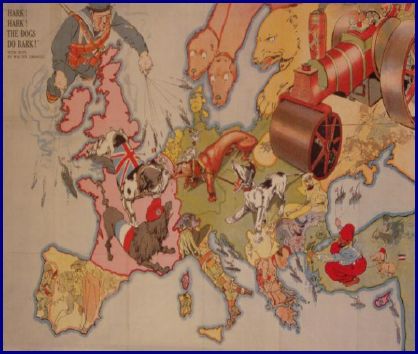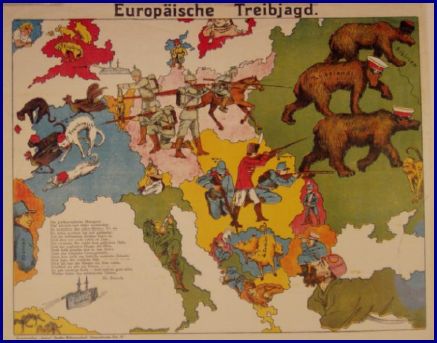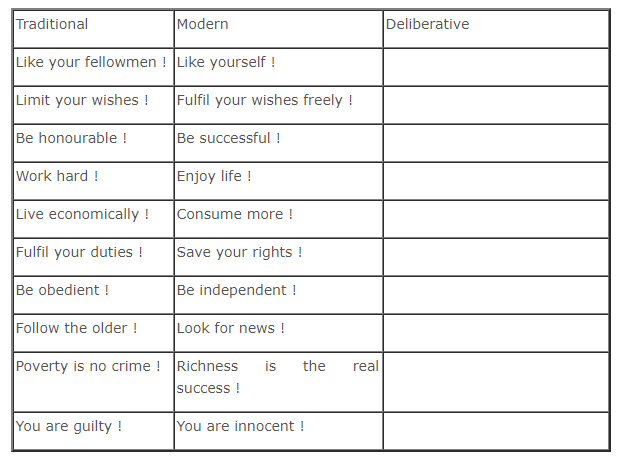A brief background - policy changing in central european countries
During the last 10 years of the 20th century, besides the political and economical changes, there was a gigantic reform-period in Hungary as well as in other CEE countries. We can call this area a "transition period" which still exists in several segments of the new democratic societies, mainly in the field of education.
The most characteristic points of the reform are the following ones:
- Reform is considered to be an almost complete systemic and structural change;
- Reform is driven by ideological and political consideration (against the heritage of the communist area);
- The speed of the economic and social environment transformation is very high;
- Educational reform is an inherent component of the overall transition agenda;
- Reform is about the top-down implementation of systematic changes;
- Reform can be interpreted as a transformation of "command driven" system into "demand driven" system 1 . (Radó, 2001)
In Hungary, due to the general reform policy, the structure and the content of the curriculum had been changed by law in 1993 and the National Core Curriculum announced by the minister of education in 1995. Based on a central definition of each discipline, the schools and the local teaching staff can define and adopt local curricula and syllabi for each class and each subject. The revised National Core Curriculum (2003) has the special feature of giving priority to the improvement of skills and abilities. The choice of teaching methods is discussed by the teachers, the parents and all stakeholders of each educational institution. The choice of textbooks is the responsibility of the teaching staff; however, the Ministry of Education approves the list of eligible textbooks.
It is important to emphasize that the recent rapid changes in the curricular system have not been implemented fully yet. At this moment, there are three curricular systems in existence (in parallel at different levels and type of education) in Hungary.
Horizontally, the administrative responsibilities are shared between the Ministry of Education and other ministries (primarily the Ministry of Employment and Social Affairs, the Ministry of Finance and the Ministry of Interior). Vertically, the administrative control is decentralized and the managing responsibility is shared between central (national), local (regional) and institutional levels.
The local governments administer pre-primary, primary and secondary education. The different establishments enjoy a fair degree of decision-making autonomy not only in terms of organization and functioning but also with regard to their budgets 2 .
The whole process of transition was influenced by the enlargement process of the European Union. In 1991 the Maastricht treaty laid down the objectives of the Union actions in general education:
- Development of European dimension in education (first of all by teaching and spreading the languages of the member states);
- Fostering the mobility of students and educators;
- Supporting co-operation among educational institutions;
- Exchange of information and experiences concerning key matters of education in the member states;
- Exchanges programs. (Radó, 2001)
During the period, the Teacher Training College of Kecskemét was fortunate to participate in different international projects (TEMPUS, PHARE, FEFA) financed by the EU or the World Bank, and almost all the future partnerships were based on these connections. Besides strengthening foreign language teaching within elementary teacher training programme, the projects emphasized quality assurance, curriculum and resources development as well.
By the end of the 20th century, the College, the programme and of course staff were prepared to participate in SOCRATES-ERASMUS project: due to the level of foreign language skills of the persons involved in the international mobility there is a quite good rate between incoming and outgoing students/teachers.
Needs indicated by the new curriculum
While the international projects gave real opportunities for teaching and administrative staff to participate in international projects, the new curriculum for primary and secondary schools demanded a new structure in teacher training as well. The National Curriculum has a special comprehensive study area titled "Man and Society" which emphasizes the contents and competences of civic education including European citizenship.
The experiences of the international programmes and the real possibilities of curriculum development indicated the first version of the "European studies", the module of 30 hours included among the subjects with compulsory choices.
The title and the content of the module were as follows:
”Key Questions of the European Integration
Objectives:
The aim of the course is to promote students to get acquainted with the historical and economical aspects of the European integration, events preceding and leading up to the integration process, the influence and the execution of EU institutions.
Main themes:
Theory of the International Integration
The History of the Integration
The Institutions of the EU
The Process of Integration
Integration and Modernization
Agriculture in the EU
The Social Charta
Characteristics of Foreign Affairs
The European Union and Hungary
Europe - 2002."
As many other subjects in the Man and Society area, this module was rather theoretic, emphasising the historical and economical aspects of the European integration. As it has never been implemented into practice, some year later - having more international experiences - the module has been modified. We kept only the most important theoretical features, modified the methods, including discussions, debate, independent work, improving the methodological aspects of the European dimension.
The new module was as follows:
"Objectives:
The course provides an introduction to the evolution of European integration and the present situation (policy, law, business, society, institutions etc.) of the European Union. It considers "Europe" and its component countries and regions through the exploration of the complexity of the economical, political and cultural traditions. It discusses the meaning and different interpretations of political and economical concepts and the possibilities (advantages and disadvantages) of the enlargement.
Learning outcomes:
- Appreciate the significance of disparities and inequalities between the different peoples, societies, economies and regions of Europe;
- Consider the development of the EU with particular reference to the moves towards greater social European integration;
- Demonstrate an understanding of the implications of the European Monetary Union;
- Demonstrate knowledge of the government institutions of the European Union.
Main topics of the course:
- "European Dimension" - How to define Europe?
- Development of the European Integration
- Unity versus Diversity
- European Community Law and its Integration at a National Level
- Introduction to European Society - National and European Identity
- Economics of the EU
- Education and Youth Work in the EU - Mobility
Assessment: final report, essay"
This type of module was the basis of teaching European studies to full time and part time students with the specialization of Man and Society during the past 4-5 academic years. The content of the course was flexible enough to follow the up-to-date issues of the enlargement and the Hungarian participation in the EU. Each group had different interest towards social, political, economical, cultural movements, but the educational aspects appeared at every occasion, when students had chosen the module. As an assessment student had to do independent work on a certain topic: document analysis, school project or international project concerning European issues. Those students, who concentrated on school projects, had quite good result to show the ways of teaching European studies at elementary level.
Within the programmes of further education for in-service teachers, the same structure was used, but in a really concentrated way, with altogether 5-6 hours consultation. The assessment has been the same, but the possibility of the topic "European Dimension in Teaching Practice" was offered for them. By this time, only one final essay was done in this field, but it was very successful.
Experience in national context
The general experience after 5-6 year teaching of the module is a bit ambivalent: among Hungarian students and teachers I observed a really low level of knowledge and interest in the European dimension. Their knowledge is rather historical, concentrated on the events of the past, and they do not understand the problems of the present situation. Parallel with the general opinion of the people in CEE countries, they had irrelevant expectations toward the enlargement, and used to have problems to understand the economic requirement of the EU administration. (Halász, 2006)
In the field of education, only students and teachers with international experiences (studies abroad, good foreign language skills or involvement in European projects) were able to make innovative productions at the end of the module. Nevertheless, the most important goal of the modules was to improve general interests in European issues, values and the up-to-date problems of the enlargement. With this approach, the students and teachers were able to understand that the problems of globalisation, consummation or internationalization can be seen and solved in the European context; we easily can find those values in Europe which help us to keep respect towards each other and built up a common, liveable continent; the European connections and partnerships can show the "good examples" as well; the diversity of cultures and languages gives opportunities to get acquainted with the richness of the world.
International modules
On the basis of our own European module and the international exchange programmes, we organised during the past ten years, we had the challenge to realise the different modules of the ISTEPEC project.
In Kecskemét, altogether five modules have been organised with more than fifty foreign participants from six different countries (France, Great-Britain, Italy, the Netherlands, Spain, and Sweden). Within the participants Finish and German nationalities could be found as well. Each company gave the opportunity for intercultural meetings, discussions and negotiations on widely different topics, including languages teaching, cultural diversity, global issues, sustainable development and environmental problems.
In Kecskemét, two modules had been organised in 2005, 2006 and one in 2007. The participants from six different countries visited more than 120 classes in primary and secondary schools. Within this large number of observations languages classes, there was a dominance of representation, arts and communication were presented as well, and more then 30 (approx. 25%) showed connection to sustainable development: environmental studies in primary classes, sciences in secondary schools. Economy and social sciences have been less represented, but showed significant connection towards sustainable development (entrepreneurship, equal chances, human rights etc.). The students were informed about the activities of each school, studied the decorations, installations and sometimes the presentation of the children.
The most successful dimension of the international seminars was the content of the final presentations made by different international groups of the participants (group-size of 3 or 4 students with different nationalities and subject area). We asked the guest students to make cross-curricular projects with a clear European focus, to be presented to the whole group.
The characteristic themes are as follows:
- The role of science in intercultural education;
- The role of arts in intercultural education;
- The role of foreign languages teaching in intercultural education;
- The role of conscious environmental attitude in intercultural education;
- The role of verbal and non-verbal communication in intercultural education;
- The role of humour in intercultural education.
The topics concerning arts, foreign language and environment were the most popular themes among students both in individual and group work. The participants were free to use any type of pictures, materials made by themselves or downloaded from the internet. Global problems, questions of the modern civilisation, future of the natural and built environment, or possibilities of the multicultural societies - these topics are not only the headlines of the current media, but must be the most important themes of the curriculum. It would be an indispensable requirement of teacher training to prepare students to be able to use intercultural and deliberative communication dealing with the actual problems of the continent, to find the pedagogical aspects of the questions towards globalization, to emphasise common and individual responsibility concerning sustainable development.
Experiences in international context
Comparing the results of the European modules offered and realised in national and international context, we can say that the international modules gave more useful, innovative productions, good examples of creative discussions, debates, and critical but respectful atmosphere with highly motivated participants. It was quite simple recognizable, that after the first, rather "experimental" year, the participants have been much more prepared; they came to Hungary with clear expectations, they have had previous ideas on the project ISTEPEC.
The method used among the foreign students, that can be and should be used with Hungarian students as well, included practical duties, debates, group and independent work. The continuous work needs to take special consideration on the following questions:
1. How to define Europe as historical, geographical and cultural phenomena?
2. How to motivate participants to get acquainted with European issues?
3. How to promote European identity and citizenship?
4. How to balance national and international features of European values, movements and relations?
5. How to develop critical thinking and intercultural communication within European studies?
The possible answers we have got after realising the international modules for five different groups from 2005 to 2007 in Kecskemét are the following ones:
1. The definition of Europe is not a simple problem: we have to make clear distinctions between geographical, historical and cultural (religious) aspects, using maps 3 , ancients pictures, texts (e.g. legend of Europe).


We have to draw the borders according to the EU as well, emphasising the process of enlargement in 1958-2006.
2. It is a possible way to give a brief summary on the history of European integration, supplemented by quotations from different documents (treaties, statements, summaries, like Schumann’s declaration, documents of Maastricht, Nice, Lisbon, Berlin etc.) Documents are available at the following website: www.eu.int.
3. One of the most difficult questions is how to promote European identity and citizenship. First of all, it is necessary to discuss the elements and the structure of human identity, emphasising the complexity and the diversity of it, depending on the given situation. Without strong citizenship education and training, it is almost impossible to speak about European citizenship. Students have to understand the decision-making system of the international boards, the connection between national and international level of compulsory and advised directions, and the preferences of community interests in several issues.
4. Explanations should be based on the general human values, showing the hierarchy among them, notifying the common features of national, European and global levels. (IUFM, 2001) The different lists made by excellent experts might help to find the starting point, like peace, autonomy, co-operation, equity, respect, tolerance, solidarity, justice, responsibility etc. 4 The fact, than the session can be followed by text, document, data or just fact (event) analysis searching for certain values, appeared in different moments.
It was an interesting but really difficult exercise to find deliberative terms expressing certain values and attitudes that appeared in multicultural s ocieties 5 . (Hankiss, 1999) Students enjoyed the freedom to create as many "good" answer as possible, finding descriptive formulations instead of normative ones or discover concessions:

The last step can be represented by finding the consequences: What is the connection between manifestations of values in different contests? Is there any relation between movements and values? Is it true to realise differences between national and international approaches?
5. The method mentioned in 1-4 automatically develops students’ critical thinking and communicative skills, mainly through text analysis and discussions. It is always important to reflect the conflicts of different groups, communities, interests. It might be clear that to be European (European identity) is not a simple status, we have to rebuilt it many times and have to work on it to keep its benefits as long as possible.
Conclusions
Teaching Europe would be much more efficient if we use concrete and up-to-date information to obtain personal interest and individual participation in different debates, projects, presentations, and later on independent actions as well.
Foreign languages skills and international experiences are essential to promote European identity and citizenship education.
To teach Europe is more than simple subject among others: it means a special point of view understanding the complexity of 21st century challenges and conflicts between opinions, nations, and traditions, and to promote an attitude of problem solving mentality.
European identity and citizenship are based on common and universal values leading people’s mind to understand the questions of globalization and internationalization.
Bibliography
Education and Equity in OECD Countries. 1997, OECD
GAZDAG, Ferenc. 1999. Európai integrációs intézmények, Osiris, Bp
HANKISS, Elemér. 1999. Proletár reneszánsz - Tanulmányok az európai civilizációról és a magyar társadalomról. Helikon Kiadó, Bp. ISBN 963 208 567 1
Council of European Union. 2001, The Concrete Future Objectives of Education and Training Systems. Report from Education Council to The European Council. Brussels
Être citoyen en Europe. 2001 - Stage COMENIUS ES 41063, IUFM de Bretagne
RADÓ, Péter. 2001. Transition is Education. Institute for Educational Policy. Budapest. 103.p.
Balancing National and local Responsibilities - Education management and Finance in Four Central European Countries. 2002. Edited by Kenneth Davey. Local Government and Public Service Reform Initiative. Open Society Institute. Budapest
Education in Hungary. Ministry of Education, 2005
HALÁSZ, Gábor. 2006. "Uniós hatások a magyar közoktatásban 2002 és 2006 között". In: EDUCATIO, 3-25. ISSN 1216-3384
-
”Command driven" system is centralized and controlled, focuses on resources, teaching is in the centre of pedagogy, while ”demand driven" system is decentralized and liberalized, focuses on learning outcomes; students are in the centre of policies. ↩
-
Education in Hungary: www.okm.gov.hu ↩
-
Emanuel, Walter: Hark! Hark! The dogs do bark! Serio-comique map of Europe at war, London, 1914 OSZK Térképtár (Széchenyi Library Map Collection): T 9 304, Europaische Triebjagd, Berlin, Kunstverlag "Junos", 1914 OSZK Térképtár: T 3 157 ↩
-
The list found in booklet edited by IUFM the Bretagne (Être citoyen en Europe - Stage COMENIUS ES 41063) was really useful with Hungarian and foreign students as well. (Annexe 2, page 72) ↩
-
Source: Elemér Hankiss: Proletár reneszánsz - Tanulmányok az európai civilizációról és a magyar társadalomról. Helikon Kiadó, Bp. 1999, p. 26. ↩